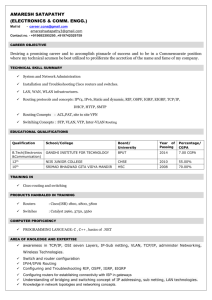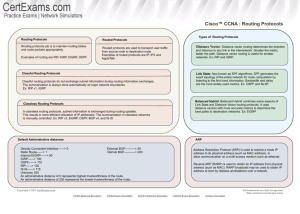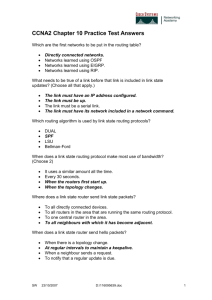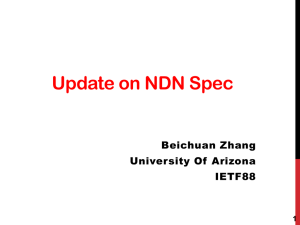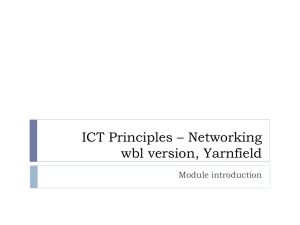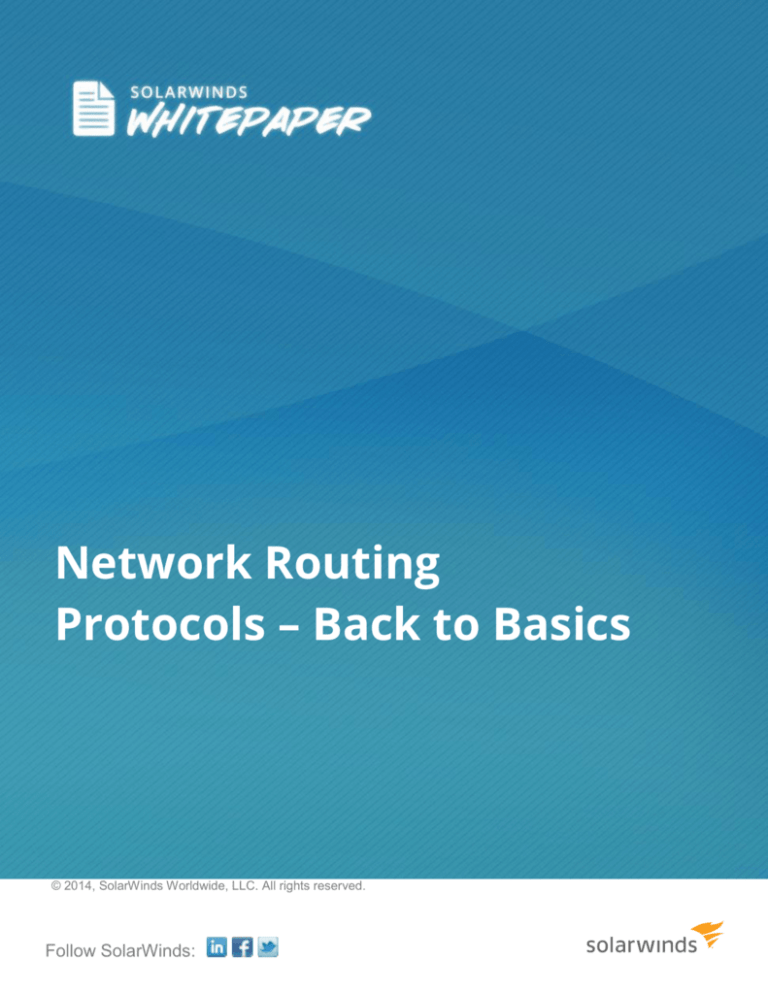
Network Routing
Protocols – Back to Basics
© 2014, SolarWinds Worldwide, LLC. All rights reserved.
Follow SolarWinds:
Routing protocols are used to determine the optimal path for data communication between network nodes.
Routers use them to share routing information with other routers to dynamically build global routing tables. The
routing protocols are employed when your organization’s network grows to the point where static routes are
unmanageable. Modern enterprise networks need dynamic routing tables that automatically adjust if there are any
traffic or topology changes.
Different Types of Routing Protocols
There are two major classes of routing protocols: Exterior Gateway Protocol (EGP) and Interior Gateway Protocol
(IGP). EGP is used to exchange routing information between autonomous systems. For instance, EGP is used in data
transfers between ISPs (Internet Service Providers) to ISPs or between autonomous systems to ISPs. Whereas, IGP
(Interior Gateway Protocol) is used for exchanging routing information between routers within an autonomous
system, like data transfers within your organization’s local area network (LAN). IGP can be further classified into two
categories: Distance-Vector and Link-State Routing Protocols.
Types of Routing Protocols
Exterior Gateway Protocols (EGP)
Border Gateway Protocol (BGP)
Interior Gateway Protocols (IGP)
Distance - Vector
RIP
IGRP
EIGRP
Link - State
OSPF
IS - IS
In Distance-Vector Routing Protocols, routers communicate with neighboring routers, periodically informing them
about network topology changes. Whereas in link-state routing protocol, routers create a roadmap of how they are
connected in the network. By calculating the best path from that router to every possible destination in the network,
link state routing protocols form the routing table. RIP (Routing Information Protocol), RIPv2, IGRP (Interior Gateway
Routing Protocol), and EIGRP (Enhanced IGRP) are part of Distance-Vector Routing Protocols. However, OSPF (Open
Shortest Path First) and IS-IS (Intermediate System to Intermediate System) are part of Link-State Routing Protocols.
Follow SolarWinds:
2
Open Shortest Path First (OSPF)
OSPF, a link - state routing protocol, is used in large organizations for their Autonomous System (AS) networks.
OSPF gathers link state information from available routers and determines the routing table information to forward
packets to based on the destination IP address. This occurs by creating a topology map for the network. Any change
in the link is immediately detected and the information is forwarded to all other routers, meaning they also have the
same routing table information. Unlike RIP, OSPF only multicasts routing information when there’s a change in the
network. OSPF is used in complex networks that are subdivided to ease network administration and optimize traffic.
It quickly calculates the shortest path if topology changes, using minimum network traffic.
Version #
Type
Packet Length
Router ID
Area ID
Check Sum
AuthType
Authentication
Authentication
Figure 1: OSPF Packet Format
OSPF allows network admins to assign cost metrics for a particular router so that some paths are given higher
preference. OSPF also provides an additional level of routing protection capability and ensures that all routing
protocol exchanges are authenticated.
OSPF Message Types
OSPF doesn’t send information using UDP. Instead, it builds IP datagrams directly, packaging them using protocol
number 89 for the IP protocol field. Different message types of OSPF include:
Hello Packet – Sent by routers to set up relationships with neighbors and communicate frequently to keep
the connection alive. Hello Packet shares key parameters on how OSPF is to be used within the network.
Follow SolarWinds:
3
Database Description – The description of the link state database for autonomous systems are transmitted
from one router to another.
Link State Request – This is requested when a portion of the network needs to be updated with current
information. The message specifies exactly which links are requested by the device that wants more current
information.
Link State Update – This contains the updated information for the requested links. It’s sent in response to
the LS request.
Link State Acknowledgement – This acknowledges the link-state exchange process for link state update
message.
OSPF – Pros and Cons
OSPF routing protocol has a complete knowledge of network topology allowing routers to calculate routes based on
incoming requests. Additionally, OSPF has no limitations in hop count, it converges faster than RIP, and has better
load balancing. A downside with OSPF is that it doesn’t scale when there are more routers added to the network.
This is because it maintains multiple copies of routing information. An OSPF network with intermittent links can
increase traffic every time a router sends information. This lack of scalability in OSPF makes it unsuitable for routing
across the Internet.
Routing Information Protocol (RIP)
Routing Information Protocol (RIP), is one of the most commonly used routing protocols for small homogeneous
networks. As a distance-vector routing protocol, RIP is used by routers to exchange topology information
periodically by sending out routing table details to neighboring routers every 30 seconds. These neighboring
routers in turn forward the information to other routers until they reach network convergence. RIP uses the hop
count metric with the maximum limit of 15 hops, anything beyond that is unreachable. Because of this, RIP is not
suitable for large, complex networks.
RIPv1 vs. RIPv2
There are two versions of RIP. RIP version 1 uses classful routing and does not include subnet information while
sending out periodic routing table updates. RIPv2 is classless and includes the subnet information supporting
Follow SolarWinds:
4
Classless-Inter Domain Routing (CIDR). Unlike RIP version 1, version 2 multicasts the routing updates to the adjacent
routers using the address 224.0.0.9. Network convergence happens much faster in RIPv2.
Command
Version
Address Family Identifier
Must be Zero (Unused)
Route Tag
IP Address
Subnet Mask
Next Hop
Metric
Figure 2 RIPv2 Packet Format
RIP – Advantages and Disadvantages
Routing Information Protocol has its own advantages in small networks. It’s easy to understand, configure, widely
used, and is supported by almost all routers. Since its limited to 15 hops, any router beyond that distance is
considered as infinity, and hence unreachable. If implemented in a large network, RIP can create a traffic bottleneck
by multicasting all the routing tables every 30 seconds, which is bandwidth intensive. RIP has very slow network
convergence in large networks. The routing updates take up significant bandwidth leaving behind very limited
resources for critical IT processes. RIP doesn’t support multiple paths on the same route and is likely to have more
routing loops resulting in a loss of transferred data. RIP uses fixed hop count metrics to compare available routes,
which cannot be used when routes are selected based on real-time data. This results in an increased delay in
delivering packets and overloads network operations due to repeated processes.
Enhanced Interior Gateway Routing Protocol (EIGRP)
EIGRP, a distance vector routing protocol, exchanges routing table information with neighboring routers in an
autonomous system. Unlike RIP, EIGRP shares routing table information that is not available in the neighboring
routers, thereby reducing unwanted traffic transmitted through routers. EIGRP is an enhanced version of IGRP and
uses Diffusing Update Algorithm (DUAL), which reduces the time taken for network convergence and improves
Follow SolarWinds:
5
operational efficiency. EIGRP was a proprietary protocol from Cisco®, which was later made an Open Standard in
2013.
Version
OPCode
CheckSum
Flag
Sequence Number
Acknowledgement Number
Autonomous System (AS) Number
Type/Length/Value
Figure 3 EIGRP Packet Format
EIGRP Packet Types
Different message types in EIGRP include:
Hello Packet – The first message type sent when EIGRP process is initiated on the router. Hello packet
identifies neighbors and forms adjacencies while being multicast every 5 seconds by default (60 seconds on
low bandwidth network).
Update Packet – Contains route information that is only forwarded when there is a change. They are only
sent to the routes that have partial updates. If there’s a new neighbor discovered, the packet is then sent to
the router as a unicast.
Acknowledgement – This is unicast as a response to Update packet by acknowledging when they receive an
update.
Query – This packet is sent to query routes from neighbors. When a router loses a route while sending the
multicast, Query packet is sent to all neighboring routers to find alternate paths for the router.
Reply – These are unicast by routers that know alternate routes for the neighboring routers queried on a
network.
Follow SolarWinds:
6
EIGRP – Pros and Cons
Speedy network convergence, low CPU utilization, and ease of configuration are some of the advantages of EIGRP.
The EIGRP routers store everything as routing table information so they can quickly adapt to alternate routes. The
variable length subnet mask reduces time to network convergence and increases scalability. EIGRP also includes
MD5 route authentication. Compared to RIP and OSPF, EIGRP has more adaptability and versatility in complex
networks. EIGRP combines many features of both link-state and distance-vector. Since EIGRP is mostly deployed in
large networks, routers tend to delay sending information during allotted time, which can cause neighboring
routers to query the information again, thus increasing traffic.
How to Choose a Suitable Routing Protocol for Your Network
Distance vector routing Protocols like RIP and EIGRP are ideal for small networks that are simple and nonhierarchical. Enterprises use link state routing protocols like OSPF and IS-IS for their large and hierarchical networks,
while distributed networks will use BGP to establish routing information between autonomous systems. For
instance, network administrators using OSPF will have advanced knowledge about complex networks which helps
them in troubleshooting routing related issues.
Network admins choose routing protocols based on convergence time: the time taken for all the routers to collect
the status of current topological information about the network. If you have three routers in the network and one of
the links that connects the network has failed, the information about the status should be immediately available in
all the routers by the process of convergence. The slower they converge, the harder they become for network
admins to troubleshoot. Focusing on easing network route management, network configuration and
troubleshooting become very important to admins managing large enterprise networks.
How SolarWinds® Can Help
Advanced network monitoring tools have the ability to monitor network route information and provide real-time
views on issues that might affect the network. SolarWinds Network Performance Monitor (NPM) is a network
fault, availability, and performance management software that enables you to monitor and alert on large, complex
network routes including support for major routing protocols (RIP v2, OSPF v2 & v3, EIGRP, BGP). As your network
size and complexity grow and change it becomes increasingly difficult to monitor and troubleshoot routing related
performance issues. Manually retrieving route information using CLI is time consuming and error prone.
Follow SolarWinds:
7
SolarWinds NPM gives you the ability to monitor network route information and receive alerts when issues arise,
enabling you to reduce your time to resolution by providing a combined view of real-time network route
information alongside device information. You can now view routing tables, changes in default routes, BGP
transitions and flapping routes. It also provides visual alert indicators and audible alarms, and includes more than
sixteen built-in network alert delivery methods and responses, including email, pages, SNMP traps, text-to-speech,
syslog messages, and the launching of an external application.
About SolarWinds
SolarWinds (NYSE: SWI) provides powerful and affordable IT management software to customers worldwide.
Focused exclusively on IT pros, we strive to eliminate the complexity in IT management software that many have
been forced to accept from traditional enterprise software vendors. SolarWinds delivers on this commitment with
unexpected simplicity through products that are easy to find, buy, use, and maintain, while providing the power to
address any IT management problem on any scale. Our solutions are rooted in our deep connection to our user
base, which interacts in our online community, thwack®, to solve problems, share technology and best practices,
and directly participate in our product development process. Learn more at http://www.solarwinds.com.
Follow SolarWinds:
8


![Internetworking Technologies [Opens in New Window]](http://s3.studylib.net/store/data/007474950_1-04ba8ede092e0c026d6f82bb0c5b9cb6-300x300.png)
